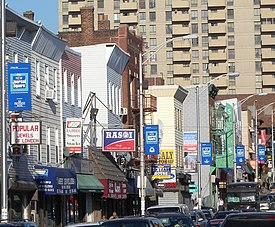This article has multiple issues. Please help improve it or discuss these issues on the talk page. (Learn how and when to remove these messages)
|
Little India
India Square in Jersey City, New Jersey, in the New York metropolitan area, is home to the highest concentration of Asian Indians in the Western Hemisphere.[1]
Little India (also known as Indian Street, India Bazaar, or India Town) is an Indian or South Asian[2][3][4] sociocultural environment outside India or the Indian subcontinent. It especially refers to an area with a significant concentration of South Asian residents and a diverse collection of Indian businesses. Frequently, Little Indias have Hindu temples, mosques, and gurdwaras. They may also host celebrations of national and religious festivals and serve as gathering places for South Asians. As such, they are microcosms of India. Little Indias are often tourist attractions and are frequented by fans of Indian cuisine, Indian culture, Indian clothing, Indian music, and Indian cinema.[5][6][7]
- ^ Cite error: The named reference
Laryssa Wirstiukwas invoked but never defined (see the help page). - ^ "The radical history of Southall, London's Little India". 21 October 2020.
The reference to India is owed to the abundance of South Asians occupying the district... It was in the 1950s that South Asians began to migrate to this area, mostly for job opportunities.
- ^ "Little India: Six blocks, many stories". The Toronto Star. 25 August 2007.
"As the first neighbourhood for the community, it seems to play an important role in people's memories of growing up South Asian in Toronto," says Haema Sivanesan, executive director of the South Asian Visual Artists Collective.
- ^ "Jackson Heights Indians".
The term 'Indian' encompasses a wider-ranged area than the specific politically-bound region of recent history, and includes those of that particular ethnic and geographic background bound in by the Indian Ocean, Himalayan Mountain Range, and western deserts, excepting of those of Arab descent... Little India arose in Jackson Heights, which developed into a prominent commercial area for South Asian goods... The population of the area has included Indians, Pakistanis, and Bengali, among other South Asian groups.
- ^ Encyclopedia of Asian American Folklore and Folklife. p. 490.
- ^ Indian Americans. p. 62.
- ^ "Little India in the heart of Paris". Media India Group. 5 January 2017.
